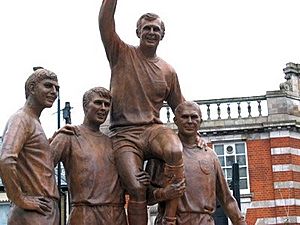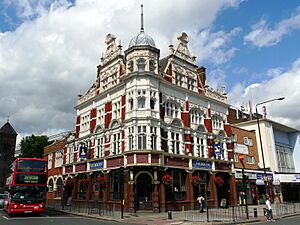Green Street, Newham facts for kids
Green Street is a famous road in East London, located in the London Borough of Newham. It acts as a boundary between the areas of East Ham and West Ham. The street ends near the Forest Gate area of Stratford.
Green Street is well-known for a few reasons. It was once home to the Boleyn Ground, the stadium for West Ham United football club from 1904 to 2016. The street is also famous for its many shops and market stalls. For over 400 years, Green Street House (also called Boleyn Castle) stood here, right next to the Boleyn Ground, until it was taken down in 1955.
Green Street stretches from Romford Road in the north to Barking Road in the south. The northern part was once called Gypsy Lane because gypsies often used it. The spot where Green Street meets Barking Road is known as Morley's Corner. This corner is home to the Champions statue. This statue celebrates the West Ham players who helped England win the 1966 World Cup: Bobby Moore, Geoff Hurst, and Martin Peters.
Contents
History of Green Street
Green Street is very old, even though the first written record of it is from the 1400s. It was chosen as the border between East and West Ham when the area was divided in the 1100s. This means the street existed even before that time. Many roads and field patterns in south Essex are from the late Iron Age and early Roman times, and Green Street might be one of them.
When the area was divided, Green Street became the main border between East and West Ham. The border also went north into Epping Forest and south through the marshes to the Thames. The area around Green Street became a town in the 1800s. The northern part of Green Street is in Forest Gate, and the southern part is in Upton Park. Both of these districts include parts of East and West Ham.
Famous Visitors: Anne Boleyn and Mahatma Gandhi
There's a local story that Anne Boleyn, the second wife of Henry VIII, lived at Green Street House. People say King Henry would visit her there. However, there's no real proof for this story.
In 1931, Mahatma Gandhi, a famous leader from India, visited London for three months. He was there for important talks about India's future. He stayed nearby and was very popular with the local people. It is said that Gandhi, who loved football, went to several West Ham games during his visit. He also supposedly visited the Boleyn Tavern on Green Street. There, he would drink cream soda and talk about football and politics with the locals.
Gandhi was a big football fan and even started three teams in South Africa. He had a connection to West Ham United through his friend Arnold Hills, who founded the club. Gandhi and Hills became friends when Gandhi was studying law in London. During his 1931 visit, Gandhi often took long walks on the nearby Sewerbank (or Greenway). He also met the famous actor Charlie Chaplin in a nearby town.
Shopping and Fashion Hub
Near Upton Park Underground station, Green Street becomes a busy shopping area. You can find many shops selling food, jewellery, and fabrics. It's also home to Queens Market. Many shops on Green Street specialise in goods from South Asia, like Bangladesh, India, and Pakistan. This is because many people in the area have strong family ties to these countries. There's also a smaller but important Afro-Caribbean community here, with shops selling Caribbean and African foods.
In the 2000s, Green Street became known for its diverse fashion. This grew after London Mayor Ken Livingstone said that the "Asian presence" in London's creative industries was a "huge asset." A journalist wrote about fashion designer Bubs Mahil, who runs a famous saree shop called Chiffons London on Green Street. She has made costumes for Bollywood star Aishwarya Rai and even clothes for British Prime Minister Tony Blair and his wife, Cherie. She also dressed other famous people like Richard Branson and Joss Stone.
Local Community
The Green Street area is divided into three local sections: Green Street East, Green Street West, and Boleyn. Together, these areas have a population of about 47,000 people. Information from the Census shows that this part of Newham is one of the most culturally diverse places in the UK. In the 1990s, many people of Asian background moved into the area. This led to Green Street being nicknamed Little India because of its lively Asian shops.
See also
 In Spanish: Green Street (Londres) para niños
In Spanish: Green Street (Londres) para niños



